
I must admit this was another experiment. I recently bought a box of cracked wheat cereal to try. I followed the directions at the back of the box for making hot cereal, since I was getting a little tired of oatmeal and would like to try something that’s new to me. However, although I must have boiled the cereal for more than ten minutes, I still found the texture a bit tough and grainy for my taste. I finally decided to try to grind it in the blender to make it finer. I usually make oat flour from regular oatmeal this way. Although the wheat grains are tougher and more difficult to grind than oatmeal, I managed to grind them finer enough for the muffins I was planning to make. As I’ve just mentioned, this is just an experiment and although it worked, next time I need to make sure that I get the correct product, which is
unprocessed wheat bran. The mashed ripe bananas, aside from adding extra flavor, sweetened the muffins naturally and made them more moist. The combination of whole grains and natural sweeteners in this recipe makes it a healthier choice either for breakfast or tea time. Grease and flour the muffin pan, this recipe makes 12 muffins. Preheat oven to 375 degrees.
Banana Bran Muffins1 cup whole wheat flour
1 cup unprocessed wheat bran
1 tbsp. baking powder
¾ tsp. salt
½ tsp. baking soda (optional)
half cup oatmeal, oat flour or cornmeal ( I used cornmeal )
half cup walnuts, chopped
¼ cup dark brown sugar
half stick or ¼ cup butter, melted
additonal ¼ cup corn oil
2 medium ripe bananas, mashed
Mix the above dry ingredients together in a big bowl, in the order given above, until just combined. The mixture will be lumpy. Then, with a wire whisk, mix the ingredients below, until well blended.
2 large eggs
¾ cup fresh milk
3 tbsps. honey or molasses
1 tsp. vanilla
Pour the egg mixture into the flour mixture, and stir with a fork until just blended. Spoon into the muffin tins. Sprinkle with some sugar and extra bran flakes before baking. Bake for 20-22 minutes or until done.
 These muffins are not very sweet and may be enjoyed with extra butter and jam.
These muffins are not very sweet and may be enjoyed with extra butter and jam.

 Fresh pears are a welcome sight with the arrival of the colder months. There are several varieties in the market and I always like to try every one of them. Bartlett, Anjou, Red Bosc, and the classic Bosc, a good choice for baking and poaching, because they are firmer and they retain their shape when cooked. Another inspirational idea from the latest issue of Everyday Food magazine, these poached pears are quick and easy to make in the microwave. Measure two tablespoons brown sugar and one tablespoon butter and combine in a microwavable bowl. The ripe pears were cored from the bottom and peeled leaving the stem intact. Place the pears over the butter and sugar combination in the bowl and cover. Microwave for 10-12 minutes depending on their ripeness. When done, the pears are transferred to serving cups or bowls. To the sauce in the bowl, about one fourth cup of vanilla ice cream was added, stirred and blended well to make an easy cream sauce. Pour the sauce over the pears. They may be served warm or chilled. It was the first time I tried this, I was surprised how good they were, literally melts in your mouth.
Fresh pears are a welcome sight with the arrival of the colder months. There are several varieties in the market and I always like to try every one of them. Bartlett, Anjou, Red Bosc, and the classic Bosc, a good choice for baking and poaching, because they are firmer and they retain their shape when cooked. Another inspirational idea from the latest issue of Everyday Food magazine, these poached pears are quick and easy to make in the microwave. Measure two tablespoons brown sugar and one tablespoon butter and combine in a microwavable bowl. The ripe pears were cored from the bottom and peeled leaving the stem intact. Place the pears over the butter and sugar combination in the bowl and cover. Microwave for 10-12 minutes depending on their ripeness. When done, the pears are transferred to serving cups or bowls. To the sauce in the bowl, about one fourth cup of vanilla ice cream was added, stirred and blended well to make an easy cream sauce. Pour the sauce over the pears. They may be served warm or chilled. It was the first time I tried this, I was surprised how good they were, literally melts in your mouth.


 Although summertime is most often associated with backyard picnics and barbecues, indoor grilling is the answer to wintertime’s grilled food cravings. Summertime, in the Philippines, reminds me of picnics at the beach and grilling, which also brings me to think about pork barbecue. This is a popular grilled specialty and a streetfood mainstay in Manila. Just like lemonade stands here, perhaps anybody in Manila can just as easily get away with setting up a small grill stand in front of his home and start grilling and selling these delicious stuff. Thinly sliced small pork pieces are marinated in a basic soy sauce and lemon juice combination, to which is added a long list of spices and other secret ingredients. The best dip for this is a simple vinegar, minced garlic, salt and pepper combination. This goes well with most grilled food. The long holiday weekend went by fast. We had a chance to try a newly-opened branch of a popular family-style Italian restaurant chain out here. I was hoping to find my favorite grilled salmon and angel hair pasta with a lemon flavored sauce in the menu, but unfortunately they have altered their menu and dropped it from their list. I ended up ordering another pasta dish instead. It was very rich, cheesy and creamy. It was very good and I enjoyed it, but my craving for something grilled remained. This inspired me to fire up my grill pan at home. I tried this combination of salmon and chicken with yellow squash and asparagus, on the side. It’s the best time to try asparagus, they’re in season now. I like this particular young or baby variety with thinner stalks. They’re very tender and tasty. I just blanched them for a few minutes but decided to grill the squash. A little lemon juice, pepper and capers added to store-bought instant hollandaise mix, makes a perfect sauce for the asparagus as well as for the other grilled stuff. This lemon-caper sauce is quick and easy to make from scratch. If a grill pan was used, the pan drippings must be scraped and transferred to a sauce pan. To the chicken drippings in the pan, add one to two tablespoons of butter, olive oil or a combination of these two. Loosen and incorporate all the pan drippings before adding a tablespoon or two of flour. The flour is then cooked for a few minutes, before adding some water or chicken broth and lemon juice to it. Season with salt and pepper. Stirring the sauce with a wire whisk is important until the sauce reaches the right consistency. More water may be added if the sauce gets too thick. Finally, stir in some capers and a few lemon slices, for garnish.
Although summertime is most often associated with backyard picnics and barbecues, indoor grilling is the answer to wintertime’s grilled food cravings. Summertime, in the Philippines, reminds me of picnics at the beach and grilling, which also brings me to think about pork barbecue. This is a popular grilled specialty and a streetfood mainstay in Manila. Just like lemonade stands here, perhaps anybody in Manila can just as easily get away with setting up a small grill stand in front of his home and start grilling and selling these delicious stuff. Thinly sliced small pork pieces are marinated in a basic soy sauce and lemon juice combination, to which is added a long list of spices and other secret ingredients. The best dip for this is a simple vinegar, minced garlic, salt and pepper combination. This goes well with most grilled food. The long holiday weekend went by fast. We had a chance to try a newly-opened branch of a popular family-style Italian restaurant chain out here. I was hoping to find my favorite grilled salmon and angel hair pasta with a lemon flavored sauce in the menu, but unfortunately they have altered their menu and dropped it from their list. I ended up ordering another pasta dish instead. It was very rich, cheesy and creamy. It was very good and I enjoyed it, but my craving for something grilled remained. This inspired me to fire up my grill pan at home. I tried this combination of salmon and chicken with yellow squash and asparagus, on the side. It’s the best time to try asparagus, they’re in season now. I like this particular young or baby variety with thinner stalks. They’re very tender and tasty. I just blanched them for a few minutes but decided to grill the squash. A little lemon juice, pepper and capers added to store-bought instant hollandaise mix, makes a perfect sauce for the asparagus as well as for the other grilled stuff. This lemon-caper sauce is quick and easy to make from scratch. If a grill pan was used, the pan drippings must be scraped and transferred to a sauce pan. To the chicken drippings in the pan, add one to two tablespoons of butter, olive oil or a combination of these two. Loosen and incorporate all the pan drippings before adding a tablespoon or two of flour. The flour is then cooked for a few minutes, before adding some water or chicken broth and lemon juice to it. Season with salt and pepper. Stirring the sauce with a wire whisk is important until the sauce reaches the right consistency. More water may be added if the sauce gets too thick. Finally, stir in some capers and a few lemon slices, for garnish.


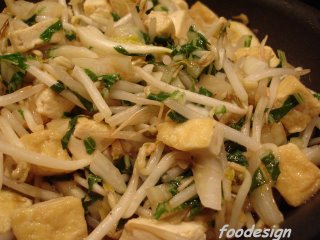
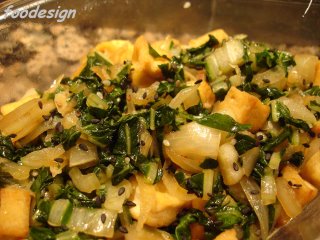

 Popularly known as beef steak or “bistek” as some would refer to it in Manila. This is comfort food Philippine-style. What’s interesting is, this dish is commonly eaten for breakfast with fried rice, eggs and tomatoes, but I guess the time of day to have it doesn’t matter at all. Breakfast back there often consists of rice with preferably some salty dish to go with it. Another popular example is rice with pan-fried spam and eggs. There’s also a much drier meat dish version, called tapa, which is very similar to beef jerky here. For the steak dish in the photo above, the beef, is very thinly sliced across the grain. For the marinade, calamansi or lemon juice, light soy sauce, ground black pepper and a little worcestershire sauce are combined together. The beef slices are browned in a little oil and piled up as they cook in a serving platter and kept warm. Sliced white or yellow onions are stir fried briefly in the same pan. As the onions start to caramelize, a little sugar is sprinkled to sweeten them up, except when using vidalla onions, since these variety are already naturally sweet. The caramelized onions are then transferred to the serving platter with the meat. The dish may be served just like this, garnished with finely sliced green onions. However, if a saucier dish is preferred, return the meat to the pan, add some water, then simmer for a few minutes more. A very flavorful dish which is best served with some vegetable side dish. I decided to make this vegetarian side dish with squash & green beans combination. I tried using butternut squash this time, I tend to buy acorn, but I discovered that the butternut variety is even better, with a deeper yellow color and much easier to peel. Add the cubed squash and cut green beans to some sauteed onions in pan. Then add some coconut milk when the veggies are half-cooked, and simmer until fully cooked.
Popularly known as beef steak or “bistek” as some would refer to it in Manila. This is comfort food Philippine-style. What’s interesting is, this dish is commonly eaten for breakfast with fried rice, eggs and tomatoes, but I guess the time of day to have it doesn’t matter at all. Breakfast back there often consists of rice with preferably some salty dish to go with it. Another popular example is rice with pan-fried spam and eggs. There’s also a much drier meat dish version, called tapa, which is very similar to beef jerky here. For the steak dish in the photo above, the beef, is very thinly sliced across the grain. For the marinade, calamansi or lemon juice, light soy sauce, ground black pepper and a little worcestershire sauce are combined together. The beef slices are browned in a little oil and piled up as they cook in a serving platter and kept warm. Sliced white or yellow onions are stir fried briefly in the same pan. As the onions start to caramelize, a little sugar is sprinkled to sweeten them up, except when using vidalla onions, since these variety are already naturally sweet. The caramelized onions are then transferred to the serving platter with the meat. The dish may be served just like this, garnished with finely sliced green onions. However, if a saucier dish is preferred, return the meat to the pan, add some water, then simmer for a few minutes more. A very flavorful dish which is best served with some vegetable side dish. I decided to make this vegetarian side dish with squash & green beans combination. I tried using butternut squash this time, I tend to buy acorn, but I discovered that the butternut variety is even better, with a deeper yellow color and much easier to peel. Add the cubed squash and cut green beans to some sauteed onions in pan. Then add some coconut milk when the veggies are half-cooked, and simmer until fully cooked.






 From fiestas, to birthdays to weddings to christenings, you name it, the Philippines is always alive with colorful celebrations. Times may be hard but Filipinos find a way to gather and have fun. And in the midst of all these gatherings is, of course, food. I’m sure most Filipinos out there will agree. I was fortunate to be back there in 2004 in time for my baby nephew's baptism. My sister-in-law cooked all these delicious food. I suggested that she should start her own food catering business, having seen and tasted all the good food she cooked for the occasion. Food business though is a big undertaking requiring much time and dedication. From top to bottom, in the photo above, are embutido ( partly hidden ), pasta carbonara, menudo, beef asado and prawns with peas & quail eggs. My other sister-in-law cooked the embutido and I helped out with the fruit salad. The chinese-style beef asado has become one of our favorite foods to serve at parties. It may be made ahead and reheats well, which makes it an ideal buffet food. In the family cookbook I'm planning to do, I would certainly give one of my aunts the credit for this dish that she has since shared with us. Combining soy and hoisin sauce with brown sugar and star anise gives this dish it’s subtle asian flavoring. The slow cooker is such a handy kitchen appliance to cook dishes like this requiring a very slow simmering process.
From fiestas, to birthdays to weddings to christenings, you name it, the Philippines is always alive with colorful celebrations. Times may be hard but Filipinos find a way to gather and have fun. And in the midst of all these gatherings is, of course, food. I’m sure most Filipinos out there will agree. I was fortunate to be back there in 2004 in time for my baby nephew's baptism. My sister-in-law cooked all these delicious food. I suggested that she should start her own food catering business, having seen and tasted all the good food she cooked for the occasion. Food business though is a big undertaking requiring much time and dedication. From top to bottom, in the photo above, are embutido ( partly hidden ), pasta carbonara, menudo, beef asado and prawns with peas & quail eggs. My other sister-in-law cooked the embutido and I helped out with the fruit salad. The chinese-style beef asado has become one of our favorite foods to serve at parties. It may be made ahead and reheats well, which makes it an ideal buffet food. In the family cookbook I'm planning to do, I would certainly give one of my aunts the credit for this dish that she has since shared with us. Combining soy and hoisin sauce with brown sugar and star anise gives this dish it’s subtle asian flavoring. The slow cooker is such a handy kitchen appliance to cook dishes like this requiring a very slow simmering process.
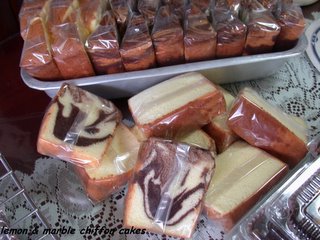
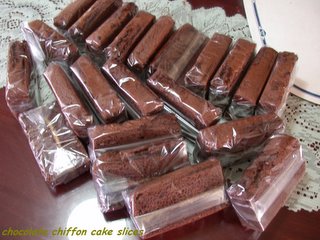 The chocolate chiffon slices, pictured above, are the very same ones I used to sell back in high school. I mentioned this in my previous post on chiffon cake. It has always been a hit, then and now. My mother was instrumental in instilling in us the love of cooking ang baking. She set the example for us by constantly experimenting and cooking in the kitchen, and I'm most grateful to her for this. I was in high school when I started with cookies and brownies but with time and practice, graduated to the more complicated and delicate chiffon cakes. Oh yes, it took several unsuccessful attempts but I have since learned the correct consistency to watch out for especially with the rather tricky beating of the eggwhites until it reached the required soft peaks stage, and then finally learning the folding technique.
The chocolate chiffon slices, pictured above, are the very same ones I used to sell back in high school. I mentioned this in my previous post on chiffon cake. It has always been a hit, then and now. My mother was instrumental in instilling in us the love of cooking ang baking. She set the example for us by constantly experimenting and cooking in the kitchen, and I'm most grateful to her for this. I was in high school when I started with cookies and brownies but with time and practice, graduated to the more complicated and delicate chiffon cakes. Oh yes, it took several unsuccessful attempts but I have since learned the correct consistency to watch out for especially with the rather tricky beating of the eggwhites until it reached the required soft peaks stage, and then finally learning the folding technique.
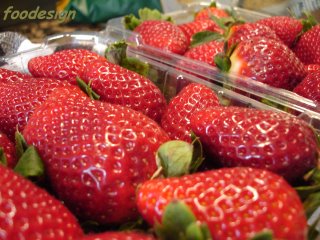
 Strawberries always remind me of our memorable Baguio vacations years ago, when we would buy and bring the ripe fruit all the way back home to Manila, only to find most of them bruised from the trip. I guess Baguio strawberries are more the smaller wild variety and I think they were just not meant to leave the cooler Baguio climate. They literally melt in Manila's hot summer. So as much as possible, as soon as we get home, they had to be consumed. One of our favorite ways to serve them is like fruit salad, with condensed milk and Nestle's brand cream.
Strawberries always remind me of our memorable Baguio vacations years ago, when we would buy and bring the ripe fruit all the way back home to Manila, only to find most of them bruised from the trip. I guess Baguio strawberries are more the smaller wild variety and I think they were just not meant to leave the cooler Baguio climate. They literally melt in Manila's hot summer. So as much as possible, as soon as we get home, they had to be consumed. One of our favorite ways to serve them is like fruit salad, with condensed milk and Nestle's brand cream.

 Using the available yellow cornmeal, combined with some whole wheat flour, I altered my basic crepe recipe to come up with the cornmeal crepes. They worked great for the enchiladas. They were thin, light and pliable which made it easy for me to wrap them around the meat filling. The basic meat filling I make is usually with lean ground beef, browned with sliced onions, chopped fresh tomatoes and flavored with cumin or southwestern spices. I usually add corn kernels and black beans to the mixture. Some grated cheese goes in with the wrapped enchiladas and also on top.
Using the available yellow cornmeal, combined with some whole wheat flour, I altered my basic crepe recipe to come up with the cornmeal crepes. They worked great for the enchiladas. They were thin, light and pliable which made it easy for me to wrap them around the meat filling. The basic meat filling I make is usually with lean ground beef, browned with sliced onions, chopped fresh tomatoes and flavored with cumin or southwestern spices. I usually add corn kernels and black beans to the mixture. Some grated cheese goes in with the wrapped enchiladas and also on top.  The enchiladas may be baked or broiled until the cheese has melted. Some minced jalapenos, fresh cilantro, lime slices, extra enchilada sauce, light sour cream and minced green onions are always good to have on the side for an extra sprinkle of flavors.
The enchiladas may be baked or broiled until the cheese has melted. Some minced jalapenos, fresh cilantro, lime slices, extra enchilada sauce, light sour cream and minced green onions are always good to have on the side for an extra sprinkle of flavors.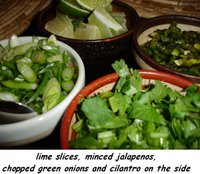 Some guacamole and tortilla chips completed our Mexican meal that night ( see spread below ).
Some guacamole and tortilla chips completed our Mexican meal that night ( see spread below ).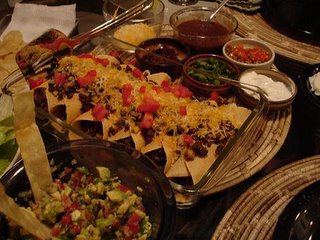



 We have started buying and trying out more whole grain food products lately and have discovered numerous brands that we like. So far we haven’t found any Hodgson Mill product we didn’t like.
We have started buying and trying out more whole grain food products lately and have discovered numerous brands that we like. So far we haven’t found any Hodgson Mill product we didn’t like.

